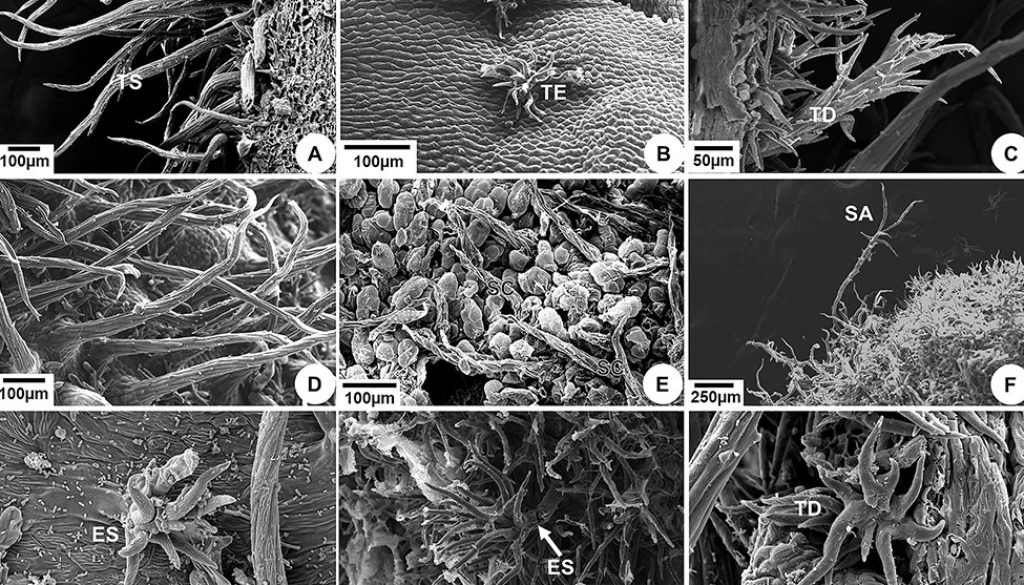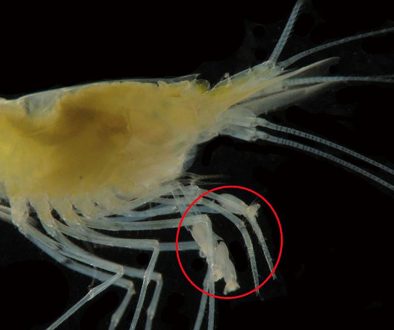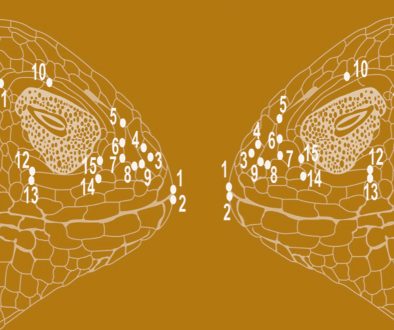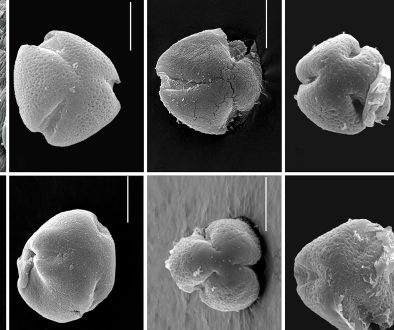Raísa Gonçales, Amanda Aparecida O. do Carmo, Anderson F. dos Santos, Luiz Antonio de Souza *
Universidade Estadual de Maringá, Programa de Pós-graduação em Biologia Comparada, Avenida Colombo 5790, Maringá, Paraná, Brasil
*Corresponding author: lasouza@uem.br (L.A. de Souza)
Received: 4 May 2023; accepted: 18 September 2023
Abstract
The tribe Miconieae was composed of a few genera, such as Miconia, Clidemia, Leandra, and Ossaea, but recent works have recognized Miconia as the only genus of the tribe. The morphological diversity of trichomes in Melastomataceae have been employed for systematic purposes, especially the foliar indumentum. In the present paper, hypanthium trichomes of 24 species of Miconieae were investigated, 8 species of Miconia sensu stricto and 16 species of Leandra, as a contribution to the taxonomy of the tribe. Samples were obtained from herbarium and plant specimens collected in a state park in Paraná, Brazil. The hypanthium indumentum of the samples was analyzed using a scanning electron microscope. Our results revealed that long-peduncle stellate trichomes appear only within Miconia s.s., while dendritic eglandular trichomes and glandular trichomes appear only in Leandra. Mixed trichomes with a lateral gland are less frequent and were found in both genera. It is not surprising, therefore, that the hypanthia of the investigated species possess indumentum of potential taxonomic significance. The characters of the indumentum of Miconia s.s., and Leandra may be useful in the infrageneric taxonomy of the new proposal for the tribe Miconieae.
Keywords: Dendritic trichomes; Hypanthium indumentum; Leandra; Mixed trichomes; Stellate trichomes
© 2023 Universidad Nacional Autónoma de México, Instituto de Biología. Este es un artículo Open Access bajo la licencia CC BY-NC-ND
(http://creativecommons.org/licenses/by-nc-nd/4.0/).
Indumento floral de Miconia: en busca de caracteres diagnósticos para la tribu Miconieae
Resumen
La tribu Miconiae estaba compuesta por los géneros Miconia, Clidemia, Leandra y Ossaea, pero trabajos recientes han reconocido a Miconia como el único género de la tribu. La diversidad morfológica de los tricomas en Melastomataceae se ha empleado con fines sistemáticos, especialmente el indumento foliar. En el presente trabajo se investigaron los tricomas del hipantio de 24 especies de Miconieae, 8 especies de Miconia sensu stricto y 16 especies de Leandra como aporte a la taxonomía de la tribu. Las muestras se obtuvieron de especímenes de herbario y plantas recolectados en un parque estatal en Paraná, Brasil. El indumento del hipantio de las muestras se analizó utilizando un microscopio electrónico de barrido. Nuestros resultados revelaron que los tricomas estrellados de pedúnculo largo aparecen solo en Miconia s.s., mientras que los tricomas dendríticos eglandulares y los tricomas glandulares aparecen solo en Leandra. Los tricomas mixtos con glándula lateral son menos frecuentes y se encontraron en ambos géneros. No sorprende, por lo tanto, que los hipantios de las especies investigadas presenten un indumento de potencial importancia taxonómica. Los caracteres del indumento de Miconia s.s. y Leandra pueden ser útiles en la taxonomía infragenérica de la nueva propuesta para la tribu Miconieae.
Palabras clave: Tricomas dendríticos; Indumento del hipantio; Leandra; Tricomas mixtos; Tricomas estrellados
© 2023 Universidad Nacional Autónoma de México, Instituto de Biología. This is an open access article under the CC BY-NC-ND license
Introduction
Melastomataceae is considered one of the 10 largest families of flowering plants, and currently has about 5,858 species (Ulloa et al., 2022). These authors also report that Brazil has 1,453 species, and is considered the country with the highest diversity in number of species in the family in the Americas and globally. The large subfamily Melastomoideae comprises 21 tribes (Ulloa et al., 2022), including the Miconieae Triana. The generic limits of this tribe have a complex history, and the number of genera recognized by different authors varies from 10 to 25 (Michelangeli et al., 2022).
Until very recently, 2 large genera have been cited for the Miconieae tribe by different authors, Miconia Ruiz & Pavón, with 1,057 described species (Caddah, 2013; Chagas, 2012), and Leandra Raddi, with about 200 known species (Camargo, 2008). However, a new publication of Michelangeli et al. (2022) recognized the tribe as composed of only the genus Miconia, which can be characterized by terminal or axillary inflorescences, each flower subtended by only 1 pair of bracteoles, or more rarely none, anthers without pedoconnectives, leaves without acicular raphides, and fruit a berry. According to Michelangeli et al. (2022), the new single-genus proposal for the Miconieae tribe should require new studies for the monogeneric tribe that contemplate a consistent revised infrageneric taxonomy.
The study of pubescence in plants has been an important research tool for angiosperm systematics, widely used to recognize families (Theobald et al., 1979; Uphof, 1962). The indument is an attribute considered fundamental in the description of Melastomataceae species, used since the first descriptions of the family by Cogniaux (1891) in the 19th century (Oliveira, 2007). The indumentum morphology represents an important character in the determination of species of some genera of Melastomataceae, even when in the vegetative state of the plant, and has become very useful for the taxonomy of the family (Guimarães et al., 1999; Wurdack, 1986). Subfamilies and tribes of Melastomataceae can be diagnosed by a combination of several characters, including the type and morphology of trichomes (Penneys et al., 2022).
Considerable effort by family specialists has been focused on resolving relationships between different taxa in Miconieae. In the present study, we selected species from 2 taxa still treated as genera of this tribe, Miconia and Leandra, for the morphological study of trichomes. In this work, we treated the studied species of Miconia as Miconia sensu stricto in opposition to those of Leandra.
The aim of this investigation was to ascertain the usefulness of indumentum of the floral hypanthium on 24 taxa of Miconia (8 species of Miconia s.s., and 16 species of Leandra) as a taxonomic character for species delimitation. Comments on the taxonomic value of the indumentum at the sectional level of both genera were also considered.
Materials and methods
Twenty-four species of Miconia (Table 1) were selected (8 from Miconia s.s., and 16 from Leandra), which occur in rupestrian vegetation in southern Brazil. The flowers of 19 species were obtained from vouchers in the Herbarium of the Museu Botânico Municipal de Curitiba (MBM), of the Botanical Garden of Curitiba, Paraná, Brazil. The flowers of the 5 other species were collected in Guartelá State Park (Tibagi, Paraná, Brazil), and the voucher specimens were deposited in the Herbarium of the State University of Maringá (HUEM) (Table 1).
The samples (flowers) were separated into pots with enough water to cover the material, then boiled in the microwave, at intervals of 20 seconds each, until they sunk. After boiling, the samples were kept at room temperature, placed in potassium hydroxide (KOH) for 2 h, washed in water (about 10 times) and subjected to the ethyl series of 10%, 30%, 50% and 70%, remaining for 1 h in each alcohol (Smith & Smith, 1942, modified). Finally, these samples were prepared for scanning electron microscopy analysis.
Examination of samples in scanning electron microscope (SEM) (from herbarium and collections). For analysis of the hypanthium indumentum, the samples were dehydrated in ethanol and dried in critical point equipment in CO2 Bal-TEC, CPD 030. The material was mounted on metal stubs for sputtering (Sputter Coater, FDU 010, Bal-Tec, Balzers, Lichtenstein), with a layer of about 10 nm of colloidal gold. The samples were examined in a Scanning Electron Microscope Quanta 250 (Fei–Oxford Instruments, Oxfordshire, United Kingdom) operating between 15-25kV, and the images captured digitally.
In general, the terminology of trichomes used in the present work was based on Wurdack (1986). For the classification of some trichomes, when not treated by Wurdack (1986), the terminology of Evert (2006) was used, such as simple trichome, for example, which is characterized by being unbranched, unicellular, or multicellular.
Table 1
Investigated species of Miconia s.s., and Leandra, with sections, sample types, and species accession number (vouchers) from the Herbarium of the Municipal Botanical Museum of Curitiba (MBM) and the Herbarium of the State University of Maringá (HUEM), Brazil.
| Genera | Sections1 | Species2 | Sample | Vouchers |
| types | ||||
| Glossocentrum | Miconia doriana Cogn. | Exsiccate | MBM 393038 | |
| M. petropolitana Cogn. | Collect (fresh) | HUEM 33142 | ||
| M. latecrenata (DC.) Naudin | Exsiccate | MBM 118436 | ||
| Miconia Ruiz | Chaenanthera | M. sellowiana Naudin | Collect (fresh) | HUEM 24957 |
| & Pav. | M. pusilliflora (DC.) Naudin | Exsiccate | MBM 271515 | |
| Cremanium | M. hyemalis A.St-Hil. & Naudin | Collect (fresh) | HUEM 32868 | |
| M. inconspicua Miq. | Exsiccate | MBM 242419 | ||
| Tamonea | M. dodecandra Cogn. | Exsiccate | MBM 222733 | |
| Leandra aurea (Cham.) Cogn. | Collect (fresh) | HUEM 24960 | ||
| L. carassana (DC.) Cogn. | Exsiccate | MBM 406179 | ||
| Carassanae | L. dusenii Cogn. | Exsiccate | MBM 133678 | |
| L. erostrata (DC.) Cogn. | Exsiccate | MBM 161451 | ||
| L. polystachya (Naudin) Cogn. | Collect (fresh) | HUEM 24968 | ||
| Oxymeris | L. acutiflora (Naudin) Cogn. | Exsiccate | MBM 79879 | |
| L. australis (Cham.) Cogn. | Exsiccate | MBM 176915 | ||
| Leandra | Niangae | L. cordifolia Cogn. | Exsiccate | MBM 224964 |
| Raddi. | L. echinata Cogn. | Exsiccate | MBM 406615 | |
| L. amplexicaulis DC. | Exsiccate | MBM 405473 | ||
| Leandraria | L. eichleri Cogn. | Exsiccate | MBM 312334 | |
| L. fragilis Cogn. | Exsiccate | MBM 42161 | ||
| L. bergiana Cogn. | Exsiccate | MBM 271528 | ||
| Chaetodon | L. calvescens (Triana) Cogn. | Exsiccate | MBM 264339 | |
| L. debilis (Naudin) Cogn. | Exsiccate | MBM 283261 | ||
| Secundiflorae | L. reversa (DC.) Cogn. | Exsiccate | MBM 267092 |
1Sections according to Cogniaux (1891). 2Species listed and treated as belonging to different clades (Goldenberg et al., 2008).
Results
A general survey of the hypanthium showed several types of indument among the species as well as marked differences in the structure of non-glandular, glandular, and mixed trichomes (Table 2). Eglandular trichomes (Fig. 1) were, in general, the most frequently observed, occurring in 19 of the 24 studied species (Table 2). The eglandular trichomes were classified as simple (Fig. 1A), stellate (Fig. 1B), or dendritic (Fig. 1C).
Simple (unbranched) eglandular trichomes were found in 1 species of Miconia s.s., and 11 species of Leandra, and in most species, they had an attenuated shape and an acute apex. In Leandra aurea, L. carassana, L. dusenii, and L. erostrata the trichomes have longer or shorter projections (Fig. 1D) on their surface. In L. debilis and L. eichleri the trichomes are elongated and contorted (Fig. 1E); in the latter species, there are acicular projections on the trichome surface (Fig. 1F).
The eglandular stellate trichomes were found in 7 species of Miconia s.s., and 4 species of Leandra (Table 2), and they consist of a short peduncle and subulate branches, with an acute apex (Fig. 1G). In Miconia hyemalis, M. inconspicua, and M. dodecandra the trichomes had a short or long peduncle and the ramifications were longer and attenuated (Fig. 1H). Dendritic eglandular trichomes had a multicellular central axis, with branches at various points on this axis, and were seen only in L. carassana and L. erostrata (Fig. 1I) (Table 2).
Table 2
Types of trichomes found in the hypanthium of Miconia s.s., and Leandra.
| Species | Eglandular trichomes | Glandular trichomes | Mixed trichomes
with lateral glands |
| Miconia doriana | StSP | – | – |
| Miconia petropolitana | – | – | + |
| Mimosa latecrenata | StSP | – | – |
| Miconia sellowiana | StSP | – | – |
| Miconia pusilliflora | StSP | – | – |
| Miconia hyemalis | SiE, SiC, StSP, StLP | – | – |
| Miconia inconspicua | StSP, StLP | – | – |
| Miconia dodecandra | StSP, StLP | -t | – |
| Leandra aurea | SiA, StSP | – | – |
| Leandra carassana | SiA, Den | – | – |
| Leandra dusenii | SiA | – | – |
| Leandra erostrata | SiA, Den | – | -t |
| Leandra polystachya | SiA, StSP | – | – |
| Leandra acutiflora | – | GSP, GOH | – |
| Leandra australis | SiA, StSP | – | – |
| Leandra cordifolia | – | GSP, GAB, GCH, GEH | – |
| Leandra echinata | StSP | GSP, GEH | – |
| Leandra amplexicaulis | SiA | GSP, GCH | – |
| Leandra eichleri | SiE, SiC | – | + |
| Leandra fragilis | SiA | GSP, GEH | – |
| Leandra bergiana | SiA | GSP, GEH | – |
| Leandra calvescens | – | GSP, GOH | + |
| Leandra debilis | SiE, SiC | GSP, GOH | – |
| Leandra reversa | – | GSP, GAB, GCH | – |
– (Absent), + (present). Eglandular trichomes: Den = dendritic; SiA = simple attenuated; SiC = simple contorted; SiE = simple elongated; StLP = stellate with long peduncle; StSP = stellate with short peduncle. Glandular trichomes: GAB = glandular with attenuated base; GCH = glandular with clavate head; GEH = glandular with elongated head; GOH = glandular with ovate head; GSP = glandular with short peduncle.
Analysis of Leandra’s hypanthia revealed 2 types of glandular trichomes, one with an elongated and attenuated peduncle and a clavate glandular head, and another with a short peduncle and an ovate or elongated glandular head. The former was recorded in L. cordifolia and L. reversa (Fig. 2A), and the latter with an ovate glandular head was seen in L. acutifolia, L. amplexicaulis, L. calvescens, and L. debilis (Fig. 2B). The second type with an elongated glandular head occurs in the hypanthium of L. bergiana, L. cordifolia, L. echinata, L. fragilis, and L. reversa (Fig. 2C) (Table 2).

Mixed trichomes with lateral glands have distinct structural portions, one eglandular and the other secretory or with a lateral gland. The mixed trichome of L. eichleri (Fig. 2D) is made up of a short peduncle with a bifurcated apex, which is composed of a simple, acute, eglandular branch, and another ovate, pluricellular glandular branch. Mixed trichomes with a short peduncle and stellate apex, with an ovate glandular branch were found in L. calvescens (Fig. 2E); the same type but with a clavate glandular branch was seen in M. petropolitana (Fig. 2F).
Discussion
Several types of hypanthium trichomes were found in both genera, and they have been classically employed for systematic purposes in the Melastomataceae (Guimarães et al., 1999; Metcalfe & Chalk, 1950; Wurdack, 1986). Wurdack (1986) showed that leaf and hypanthium trichomes are useful characters within the family, for example, pointing out that 21 species of Leandra and 112 species of Miconia s.s. can be separated by their trichome types. In addition, they showed that much parallel evolution has occurred throughout Melastomataceae, particularly within the sections of Miconia s.s.
For Todzia and Almeda (1991) and Guimarães et al. (1999), the size, shape, and differences of the base (peduncle) of the trichomes provided useful characters for identifying different taxa and evaluating their relationship, thus making it possible to evaluate distinctions among the genera, sections, and, even species. Different types of trichomes can be observed in the same species, reported for several species of Melastomataceae, and their combination can be useful in separating groups (Martins, 1989; Wurdack, 1986).

As previously mentioned, comparison of trichome types may be valuable for showing relationships or distinctness of genera or even species within the tribe Miconieae. Our results revealed that long-peduncle stellate trichomes appear only within Miconia s.s., while dendritic eglandular trichomes and glandular trichomes appear only in Leandra. Mixed trichomes with lateral glands are less frequent in the investigated species and can be found in both genera. These trichomes seem to be restricted to the tribes Miconieae and Blakeae, and were found in Miconia glyptophylla Wurdack, M. heterochaeta Wurdack, M. plumifera var. bangii Cogn., Leandra crenata (Pav. Ex D. Don) Cogn., and L. nervosa (Naudin) Cogn. (Wurdack, 1986).
In both Miconia s.s., and Leandra it is possible to identify trichomes that can be used as characters to separate sections. In Miconia, only section Cremanium had a simple elongated and contorted non glandular trichome, while the mixed type with lateral gland was observed only in section Glossocentrum. Similarly, Oliveira (2007) has recorded that Miconia trichomes can be used as criteria at the subgeneric level, reporting the occurrence of stellate eglandular trichomes in sections Chaenanthera and Tamonea, while the other sections exhibit simple trichomes on the abaxial surface of the leaf.
In our analysis of Leandra’s hypanthium, it was possible to show more significant differences between the sections. Only 5 species were analyzed for section Carassanae; it was the only section of the genus with eglandular dendritic trichomes and without a glandular type. Camargo (2008) studied foliage leaves of 20 species of the same section Carassanae. He showed that dendritic trichomes are not present in all species, then used this character to separate the species within the section. The peculiar eglandular trichome of Leandra eichleri, belonging to the section Leandraria, is conspicuous for its elongated and contorted shape (Fig. 1E, F), together with mixed trichomes with lateral glands that have also been reported in this species. The condition in section Chaetodon deserves some attention. It was the only section of Leandra that exhibited a great diversity of trichomes, with elongated and contorted simple trichomes, glandular trichomes, and mixed trichomes with lateral glands.
The indumentum of the Miconieae species analyzed in the present work was considered to consist of trichomes or hairs. However, Gonçales-Silva et al. (2019) reported that some trichomes of Melastomataceae may be emergences that originate from protodermal and subprotodermal cells. The authors based their conclusions on Uphof (1962) and Evert (2006), who gave a valuable distinction between trichomes (hairs) and emergences according to their origins. Trichomes originate exclusively from protodermal cells while emergences arise from both protodermal and subprotodermal cells.
In conclusion, it may be stated that the evaluation of hypanthium trichomes, the types found in each species, including their combination in the same species, can generate reliable characters of potential taxonomic significance within Miconieae. Trichomes have been employed for systematic purposes in Melastomataceae, but most of the work focuses on foliage leaves (for example, Guimarães et al., 1999; Oliveira, 2007). The morphological characters of the hypanthium indumentum proved to be very useful for separating Miconia s.s., and Leandra, and can be an important contribution to infrageneric taxonomy supporting Miconia as a single genus of the tribe Miconieae.
Acknowledgments
The authors would like to thank CAPES (Coordination of Superior Level Staff Improvement), CNPq (National Council of Scientific and Technological Development, Brazil), and FA (Fundação Araucária, Brazil) for the financial support granted (scholarships and funding). We also thank the Herbarium of the Botanical Museum of Curitiba (MBM) for authorizing the collection of botanical material, and COMCAP/UEM, especially the Microscopy Center, for its support in carrying out the scanning electron microscopy.
References
Caddah, M. K. (2013). Estudos taxonômicos e filogenéticos em Miconia Sect. Discolor (Melastomataceae, Miconieae) (Ph.D. Thesis). Universidade Estadual de Campinas, Campinas, São Paulo, Brazil.
Camargo, E. A. (2008). O gênero Leandra, seções Carassanae, Niangae e Secundiflorae (Melastomataceae) no Paraná (Master Thesis). Universidade Federal do Paraná, Curitiba, Paraná, Brazil. https://doi.org/10.1590/2175-7860200960308
Chagas, E. C. O. (2012). O gênero Miconia Ruiz & Pav. (Melastomataceae) na Floresta Atlântica do Nordeste Oriental (Master Thesis). Universidade Federal de Pernambuco, Recife, Pernambuco, Brazil. https://doi.org/10.5327/z1679443520180198
Cogniaux, A. (1891). Melastomataceae. In A. L. L. P. P. De Candolle, & A. C. P. De Candolle (Eds.), Monographiae phanegogamarum (pp. 321–383). Paris: G. Masson.
Dickison, W. C. (2000). Integrative plant anatomy. San Diego: Harcourt Academic Press.
Evert, R. F. (2006). Esau’s plant anatomy/meristems, cells, and tissues of the plant anatomy: their structure, function, and development. Hoboken, New Jersey: Wiley-Interscience. https://doi.org/10.1163/22941932-90001623
Goldenberg, R., Penneys, D. S., Almeda, F., Judd, W. S., & Michelangeli, F. A. (2008). Phylogeny of Miconia (Melastomataceae): patterns of stamen diversification in a megadiverse Neotropical genus. International Journal of Plant Science, 169, 963–979. https://doi.org/10.1086/589697
Gonçales-Silva, R., Almeida, O. J. G., & Souza, L. A. (2019). Leaf structural characters of Leandra and Miconia (Miconieae: Melastomataceae): taxonomic and ecological significance. Boletim do Museu Paraense Emílio Goeldi, Ciências Naturais, 14, 425–437. https://doi.org/10.46357/bcnaturais.v14i3.228
Guimarães, P. J. F., Ranga, N. T., & Martins, A. B. (1999). Morfologia dos tricomas em Tibouchina sect. Pleroma (D. Don) Cogn. (Melastomataceae). Brazilian Archives of Biology and Technology, 42, 485-493. https://doi.org/10.1590/s1516-89131999000400015
Martins, A. B. (1989). Revisão taxonômica do gênero Marcetia DC. (Melastomataceae) (Ph.D. Thesis). Universidade Estadual de Campinas, São Paulo.
Metcalfe, C. R., & Chalk, L. (1950). Anatomy of the dicotyledons —leaves, stem, and wood in relation to taxonomy with notes on economic uses. Oxford: Clarendon Press. https://doi.org/10.1126/science.112.2914.541
Michelangeli, F. A., Nicolas, A. N., Ocampo, G., Goldenberg, R., Almeda, F., Judd, W. S. et al. (2022). Why recognize Miconia as the only genus in tribe Miconieae (Melastomataceae)? In R. Goldenberg, F. A. Michelangeli, & F. Almeda (Eds.), Systematics, evolution, and ecology of Melastomataceae (pp. 235–254). Cham, Switzerland: Springer. https://doi.org/10.1007/978-3-030-99742-7_10
Oliveira, J. B. S. (2007). Anatomia foliar como subsídio à taxonomia de Miconia Ruiz et. Pav. (Melastomataceae) em Pernambuco, Brasil (Master Thesis). Universidade Federal Rural de Pernambuco, Recife. Brazil. https://doi.org/10.17138/tgft(2)136-137
Penneys, D. S., Almeda, F., Reginato, M., Michelangeli, F. A., Goldenberg, R., Fritsch, P. W. et al. (2022). A new Melastomataceae classification informed by molecular phylogenetics and morphology. In R. Goldenberg, F. A. Michelangeli, & F. Almeda (Eds.), Systematics, evolution, and ecology of Melastomataceae (pp. 109–166). Cham, Switzerland: Springer. https://doi.org/10.1007/978-3-030-99742-7_5
Smith, F. H., & Smith, E. C. (1942). Anatomy of the inferior ovary of Darbya. American Journal of Botany, 29, 464–471. https://doi.org/10.1002/j.1537-2197.1942.tb10236.x
Theobald, W. L., Krahulik, J. L., & Rollins, R. C. (1979). Trichome description and classification. In C. R. Metcalfe, & L. Chalk (Eds.), Anatomy of the dicotyledons: systematic anatomy of the leaf, stem, 2nd Ed. (pp. 40–53). Oxford, Oxford: Clarendon.
Todzia, C. A., & Almeda, F. (1991). A revision of Tibouchina section Lepidotae (Melastomataceae: Tibouchineae). Proceedings of the California Academy of Sciences, 47, 175–206.
Ulloa, C. U., Almeda, F., Goldenberg, R., Kadereit, G., Michelangeli, F. A., Penneys, D. S. et al. (2022). Melastomataceae: global diversity, distribution, and endemism. In R. Goldenberg, F. A. Michelangeli, & F. Almeda (Eds.), Systematics, evolution, and ecology of Melastomataceae (pp. 3–28). Cham, Switzerland: Springer. https://doi.org/10.1007/978-3-030-99742-7_1
Uphof, J. C. T. (1962). Plant hairs. In K. Linsbauer (Ed.), Encyclopedia of plant anatomy (pp. 1–292). Berlin: Gebrüder Borntraeger.
Wurdack, J. J. (1986). Atlas of hairs for neotropical Melastomataceae. In Smithsonian Contributions to Botany, No. 63. City of Washington: Smithsonian Institution Press. https://doi.org/10.5479/si.0081024x.63




